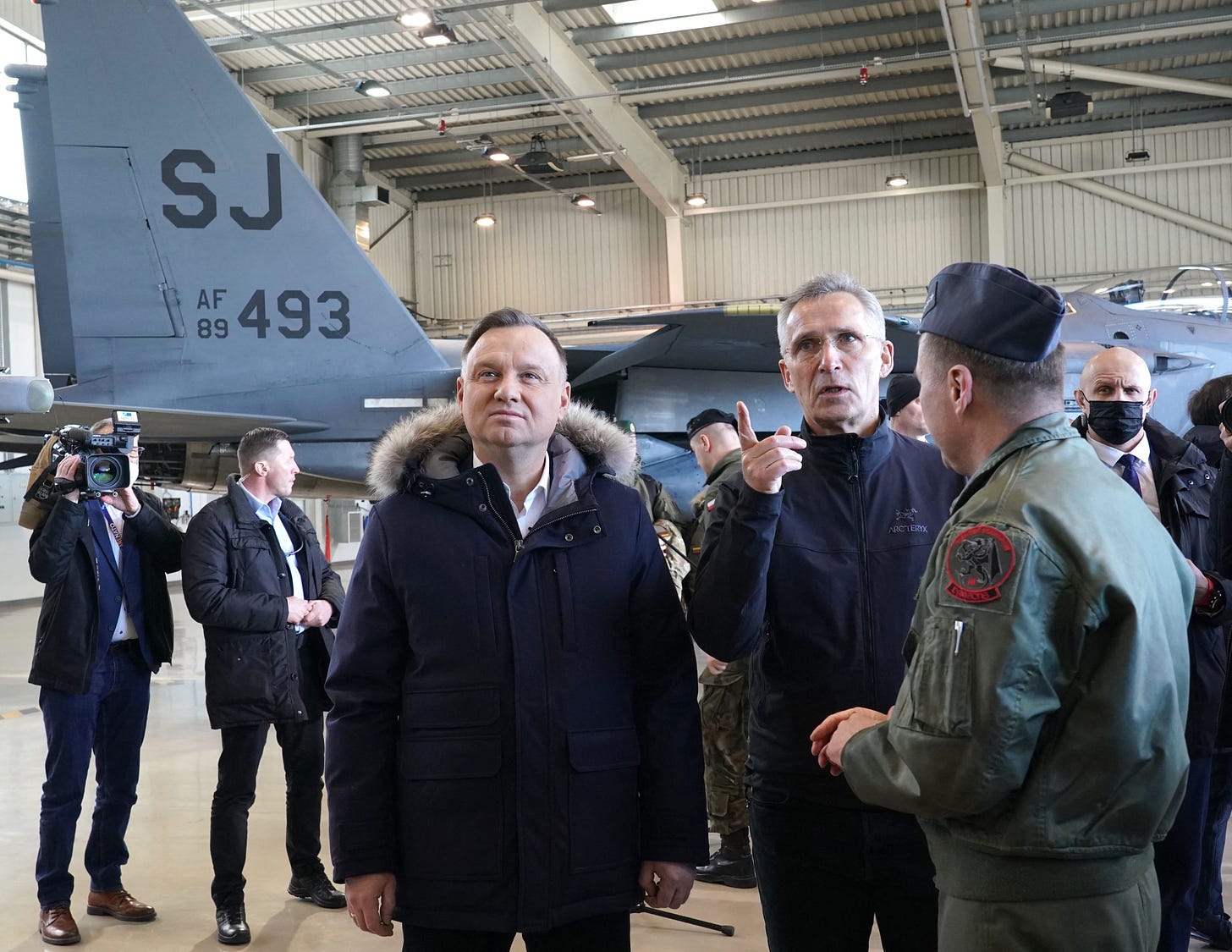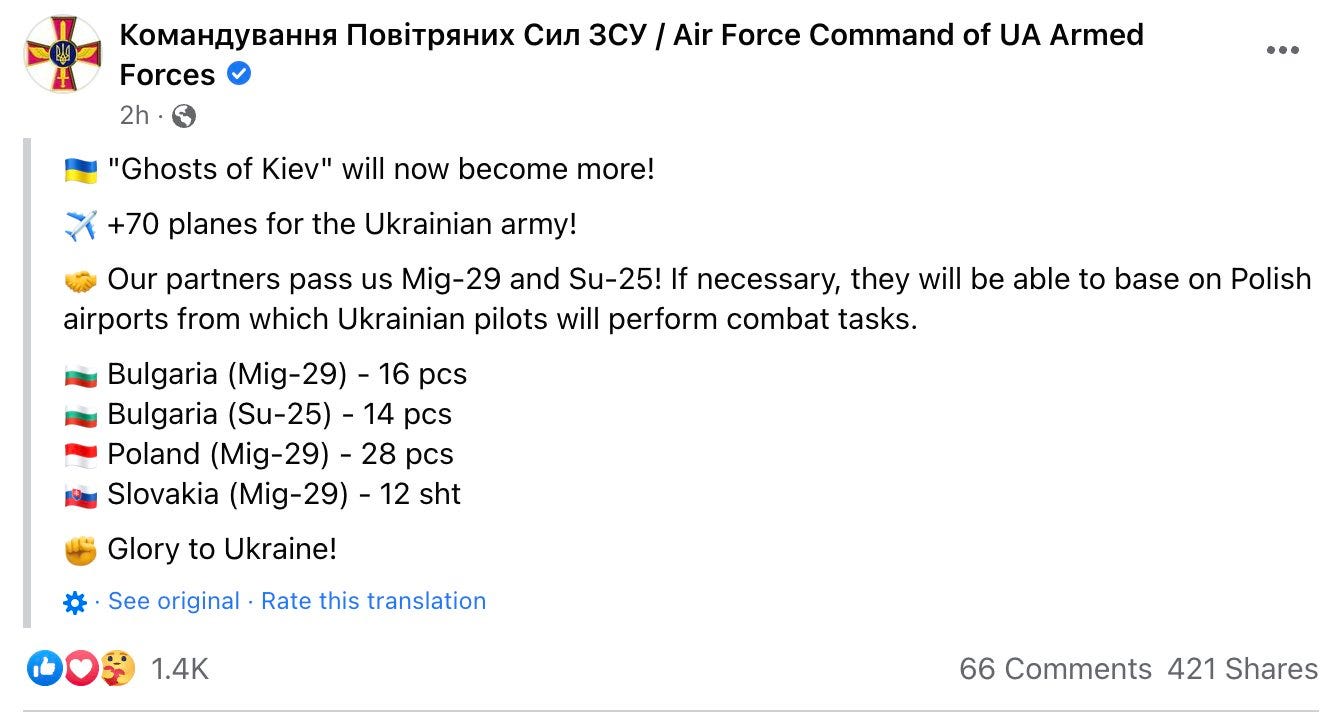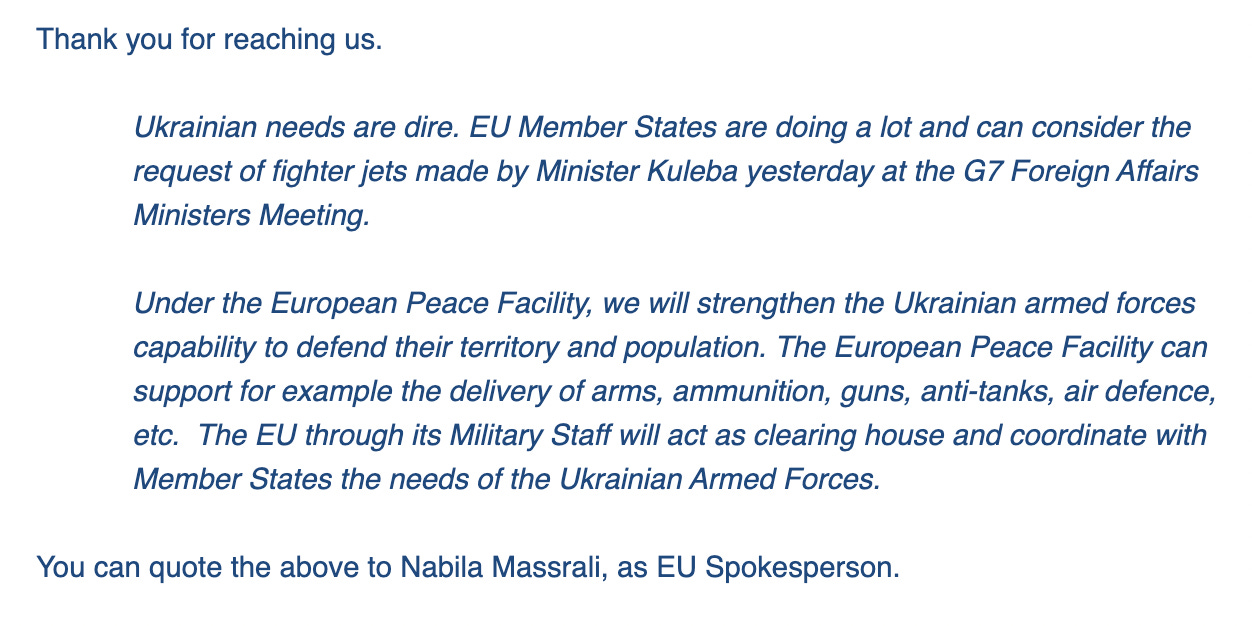
Escalation Alert: Is NATO Fighting in Ukraine Right Now?
Michael Tracey
 NATO Secretary General Jens Stoltenberg and Polish President Andrzej Duda on March 1, 2022. Photo by Janek Skarzynski/AFP via Getty Images
NATO Secretary General Jens Stoltenberg and Polish President Andrzej Duda on March 1, 2022. Photo by Janek Skarzynski/AFP via Getty Images
Even some of the most virulent foreign policy hawks you’ll ever meet have acknowledged that we are in the throes of the world's “most dangerous moment” since the Cuban Missile Crisis. The risk of wider escalation is extreme: it would only take one miscommunication or misjudgment to prompt a nuclear catastrophe, particularly with thousands of US troops maneuvering in the vicinity of an active war zone, with all the chaos and uncertainty that entails.
So here’s one surefire route to such escalation: are NATO countries currently engaged in combat operations in Ukraine? Because the difficulty one encounters attempting to answer this question doesn't make for much in the way of optimism. At least if you’d prefer to avoid World War III.
An obviously escalatory development came on Sunday night when Josep Borrell, the top “security” official for the European Union, announced the deployment of “fighter jets” to Ukraine. This was a jarring announcement, as it’s unclear what capacity the EU even had to do such an unprecedented thing. The details were also sketchy: which European countries in particular would be “sending” these fighter jets, and on what EU-related authority? Assuming the countries involved are also NATO members, how would this not amount to NATO engagement in open hostilities with Russia, potentially leading to the unfathomable war scenario which now seems to be in the cards?
Take a look at how the Ukrainian military is characterizing this process — the screenshot is from a verified Facebook account for the country’s Air Force:
Here’s the exact wording of the question I submitted to a spokesperson for the EU’s Foreign Affairs and Security Policy division, which presumably has jurisdiction over managing Borell’s “fighter jet” announcement: “Could you please describe in greater detail where these EU deployments of fighter jets to Ukraine have originated from? And who is physically flying the jets into Ukraine?”
And here’s the response I got:
If you notice… that’s not a denial that the EU is currently involved in the deployment of fighter jets to Ukraine. Nor does the answer necessarily contradict the Ukraine military’s claim that “combat tasks” are being launched from Polish bases — which would be a gigantic escalation. If anything, it’s an intentionally cryptic statement that doesn’t address what I asked at all.
So I subsequently asked Poland’s Ministry of Defense to confirm whether what the Ukrainian military is saying was true: are Polish bases really being used to launch “combat tasks” into the active war zone over the border? They provided no direct answer either, other than to refer me to a verbal statement made today by Andrzej Duda, the Polish President.
Duda held a meeting with top US / NATO military officials, and at a media appearance with NATO Secretary General Jens Stoltenberg, was asked directly about the purported “fighter jet” plan. You have to look at Duda’s words closely, and I wish I could understand what he said in the original Polish. But here’s the official English translation: “We are not sending any jets to Ukraine, that would open military interference in the Ukrainian conflict. We are not joining that conflict. NATO is not a party to that conflict… we are not going to send any jets to the Ukrainian airspace.”
Notice, however, that’s not necessarily a denial of what the Ukrainian military said was happening. Duda claims that Poland would not “send any jets to the Ukrainian airspace” — but are they allowing their bases to be used as launch points for Ukrainian fighter jet missions? It’s disturbingly unclear.
Instead, Duda’s words seem consistent with statements from other NATO leaders that they do not intend to impose a “No Fly Zone.” But there are obvious potential avenues for escalation other than a full-fledged “NFZ,” which would essentially be an overt declaration of war on Russia. Because if Polish bases are being used to launch air attacks on Russian targets, it would mean a NATO country is directly facilitating warfare against Russia — whether or not any official “No Fly Zone” has been declared. And if Russia carries out a counter-attack, NATO — i.e., the US — is treaty-bound to defend Poland. In the State of the Union speech tonight, Joe Biden just reiterated his long-time assurance that the “full force” of the US military will be deployed in the event of any attack on a NATO member state. So, what’s the deal?
The leaders of Slovakia and Bulgaria (both NATO countries) have also denied their involvement in “sending” fighter jets to Ukraine, but again, they did so in language that leaves open the possibility that something deeply escalatory is going on.
Two possible explanations:
-
The Ukraine military is outright lying when it says “combat tasks” are being launched from Polish bases, and there’s nothing like that happening at all. This would not necessarily be surprising, as Ukraine is in a state of war, and its government agencies are engaged in an all-ouer jets” announcement.
-
The Ukraine military was not lying, nor was the EU, and the leaders of Poland, Bulgaria, and Slovakia are now being forced to obfuscate their involvement in what would be an extreme escalation. Particularly Poland, which it was claimed is hosting the fighter jet missions. I have heard from people familiar with EU security policy who are deeply skeptical of these countries’ capacity to deploy fighter jets to Ukraine, let alone that that Ukrainian pilots are in any position to fly them. But it’s not impossible. No one should rule out anything out right now in the absence of verifiable fact.
Whatever the real story here, the ambiguity is highly worrisome. Stars and Stripes, the US military’s in-house newspaper, described the context “as the US and its NATO allies ramp[ing] up military support for Ukraine while trying to avoid getting drawn into the war.” Seems a bit paradoxical, don’t you think? If you were trying to avoid getting drawn into a war, isn’t “ramping up military support” the absolute last thing you’d do?
Here’s how Samuel Charap, a fairly cautious analyst at the RAND Corporation, characterized the current situation:
There seems to be a point at which the escalatory spiral is going to be out of anyone’s control. I don’t know if we’re at that point yet; but an inability to get clear answers about what’s happening is not a good sign.


